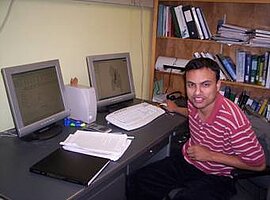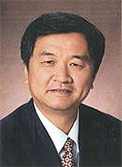Analysis and Model Simulation of Storm Water Runoff - A Study of Land Use and System Design on Discharge and Water Quality

Brajesh Gautam (M.S. Candidate) areas of research interest are wet weather flow modeling and urban stormwater runoff quantity and quality analysis. For my current work, I have been using a multi-step approach consisting of sampling and model simulation to study the effect of land use and other drainage area properties on the runoff flowrate and quality. The results from my analysis have been implemented in the Red River Total Maximum Daily Load (TMDL) report.
Degree: 2001 – B.S. in Civil Engineering, Institute of Engineering, Nepal
Fellow: Brajesh Gautam, Department of Civil Engineering
Advisor: Dr. Wei Lin, Associate Professor, Department of Civil Engineering, NDSU
Advisory Committee: Dr. G Padmanabhan, Dr. Eakalak Khan, Dr. Bernhardt Saini-Eidukat
Degree Progress: M.S. in Environmental Engineering expected in December 2005.
Analysis and Model Simulation of Storm Water Runoff - A Study of Land Use and System Design on Discharge and Water Quality
Project Background:
A project is being carried out to develop the TMDL for fecal coliform and turbidity in the impaired reaches of the Red River between 12 th Avenue N, Fargo, North Dakota and confluence of Sheyenne River. The present study is part of the TMDL development process and primarily deals with the source assessment and linkage analysis part of the project.
Data collected on the Red River during the summer of 2002 was used to identify the nature of the fecal coliform and turbidity impairment. Following conclusions were drawn from that study.
- Fecal coliform impairment was present mainly in the urban section of the river.
- High fecal coliform counts were related with rain events and stormwater runoff from urban areas was identified as the main source of fecal coliform.
- Turbidity impairment was observed in both the urban and rural section of the river. Stormwater runoff might have caused increase of turbidity but the reach was impaired in both dry and wet seasons.
Research Objectives:
Based on the observation from the summer 2002 sampling results, a study plan was developed. The purpose of the study was to get a better understanding of the broader aspect of urban runoff pollution in addition to aiding the source assessment and linkage analysis elements of the Red River TMDL development project. The approach adopted during the study was a combination of stormwater runoff sampling and computer modeling. The study focused on these principal objectives:
- Use water quality samples to determine the concentration of pollutant in storm runoff from different land use dominated areas within Fargo-Moorhead urban area
- Use flow measurement data to develop hydrograph for stormwater runoff
- Calibrate Stormwater Management Model (SWMM) for the Fargo-Moorhead urban runoff
- Calculate the Fecal Coliform and Total Suspended Solids (TSS) loads from Fargo- Moorhead urban areas
- Study the effects of land use and management practices on runoff flow and concentration of fecal coliform and TSS
Progress to date:
The work on the given research topic is in progress from the start of the year 2004. Initial phases consisted of review and study of literatures pertaining to non-point source pollution, storm water runoff and urban runoff. During the summer of 2004, runoff flow and quality sampling was carried out in different landuse dominated sub drainage areas of cities of Fargo and Moorhead. The sampling results were used to generate flow hydrograph and fecal coliform and TSS pollutograph. The initial results showed a higher concentration of fecal coliform in commercial areas. With subsequent sampling, the effects of other major factors such as antecedent dry days, intensity and duration of the rainfall were also observed.
The sampling work provided the base for modeling of the runoff. The sampling results were used to calibrate SWMM model. Matching the total volume was given priority during the hydrograph calibration process. As total load was the primary focus of the analysis, loadograph calibration was suggested instead of pollutograph calibration. The calibrated model was then simulated for calculation of total volume and total load of fecal coliform and TSS from all the Fargo Moorhead drainage areas. In addition, the SWMM model has been used as a tool to analyze the impact of Sanitary Sewer Bypass on the Red River fecal coliform concentration and to calculate the critical conditions for high fecal coliform concentration in the Red River.
Publications/ Proceeding papers:
Somayajula. S., Gautam, B., Martin, J. and Lin, W. (2005). “Application of Water Quality Modeling in Red River Fecal Coliform TMDL Development.” Presented at ‘Research and Education in an International Watershed: Implications for Decision Making’, Second International Water Conference, April 6-7, 2005, Winnipeg, Canada.
Martin, J., Somayajula, S., Gautam, B., Lin, W., Fredrick, J., and Ell, M. (2005). “Stormwater Sampling and Analysis for Red River Fecal Coliform and Turbidity TMDL Development.” Presented at ‘Research and Education in an International Watershed: Implications for Decision Making’, Second International Water Conference, April 6-7, 2005, Winnipeg, Canada

Wei Lin
Civil & Environmental Eng.
Office: Civil/Ind Eng 201D
Telephone: 701-231-6288
Email: wei.lin@ndsu.edu


